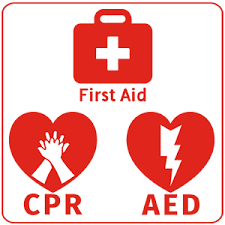MEDIC FIRST AID TRAINING WITH CPR AND AED
INTRODUCTION
Emergency first aid training is developed for those already working, or preparing to work, in the industry and who have been identified in the company’s first aid risk assessment as being required to provide first aid in the workplace. In this training will include the role and responsibilities of a first-aider, assessing an incident, unresponsive casualties (breathing and not breathing), choking, shock and minor injuries.
DURATION 6-8 hours
OBJECTIVE
This qualification has been developed specifically for those who wish to become an emergency first-aider and use a defibrillator.
Learners gaining this qualification will know basic emergency first-aid procedures and will be able to use a defibrillator correctly. The topics covered will help to maintain good practice in safe, prompt and effective emergency first-aid treatment of individuals
Key learning points:
- Responsibilities of the Emergency First Aider
- Primary Survey
- Secondary Assessment/Recovery Position
- Resuscitation/CPR
- Heart Attack
- Shock
- Stroke
- Wounds and Bleedings
- Epilepsy
- Burns and Scalds
TARGET AUDIENCE
Designed for staff at all levels, the course can be adjusted to suit the requirements of specific organizations, premises or course participants.
OUTLINE
KNOW BASIC EMERGENCY FIRST AID REQUIREMENTS
- Describe the principles that underpin basic emergency first aid support
- Explain the circumstances under which resuscitation is performed
- Explain why early intervention is necessary
- Describe different types of cardiopulmonary arrest
- Demonstrate the DRABC emergency response
- Demonstrate the top-to-toe survey of an injury
- Demonstrate how to place a casualty in the recovery position
- Identify the risks when placing a casualty in the recovery position
- Conduct major bleed control on a casualty who has suffered bleeding
- Manage hypovolemic shock treatment for a casualty
BE ABLE TO DEMONSTRATE BASIC EMERGENCY FIRST AID TECHNIQUES IN LINE WITH CURRENT GUIDELINES
- Demonstrate cardiopulmonary resuscitation (CPR)
- Demonstrate compression only resuscitation
- Demonstrate the use of resuscitation barrier devices
- Demonstrate how to manage a choking casualty
KNOW HOW TO SAFELY USE AN AUTOMAED EXTERNAL DEFIBRILLATOR
- Describe the differences between using an AED on an adult and child
- Identify safety considerations when using an automated external defibrillator
- Demonstrate the correct placement of AED electrode pads on a manikin
- Follow AED voice prompts accurately
- Demonstrate how to combine the use of an automated external defibrillator with minimal interruptions in cardiopulmonary resuscitation using a manikin
- Demonstrate the safe delivery of AED shock
- State the procedures if the casualty shows signs of life and starts to breath normally
- Identify the information required when handing over the casualty
PRACTICAL
Hands on practical exercise for CPR and use of defibrillator.
CERTIFICATION
Completion of the course and its accompanying assessment a certificate of achievement (MEDIC First Aid) is provided and valid for 2 years.
COURSE FAQS
What is the difference between first aid CPR and AED?
It is an essential aid in the CPR process. The major difference between CPR and
an AED is that CPR has very, very little chance of bringing someone back to
life after cardiac arrest, while an AED has the potential to restart their heart
and brain functions.
Who is this qualification for?
This qualification is aimed at organizations and individuals requiring Emergency
First Aid training for a workplace where people of all ages regularly attend. This
course includes the emergency action for adult, child and infant CPR and
choking.
How long will it take?
This international qualification would be typically delivered to learners through a
1-day Training course (7 hours).
Topics covered
Topics covered include the role and responsibilities of a first-aider, assessing
an incident, unresponsive casualties (breathing and not breathing), choking,
shock and minor injuries.
Assessment method
This qualification is assessed through practical demonstrations and knowledge
Assessment. HIC recommends that you contact the relevant government
Department in the country that you want to deliver the training to ensure that
There are no additional approval requirements. It may be that you are required
to register as a training provider within the country itself. HIC approves
Centers based on its own criteria, and does not represent any other organizations
or departments.





